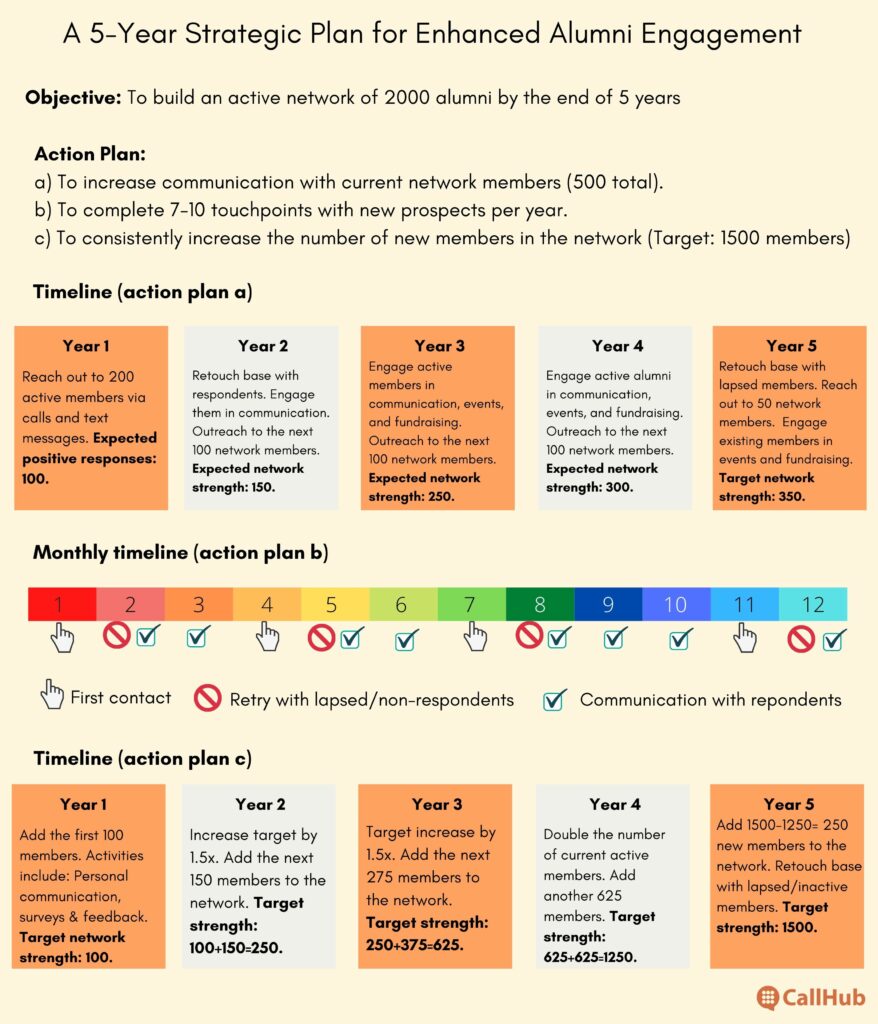

For many esteemed universities, an alumni relations strategic plan is a non-negotiable part of maintaining contact with students after they pass out. The plan considers not just a way of keeping in touch with the alumni but also setting tangible goals that
If you are struggling with maintaining strong alumni relations, this post will help you draft an alumni relations strategic plan that fulfills your objectives.
Universities and colleges often script a 5-year alumni engagement strategic plan to initiate and enhance alumni engagement. By definition, this long-term plan is a description of
The five-year term allows the alumni relations department to
Take the following plan, for example:

Here, in order to achieve the target of 2000 alumni members, three strategies are used:
These activities run simultaneously and leave scope for improvement (e.g, if there’s less success in renewing membership of current members, the team can reach out to more new members instead).
For an alumni relations department at a college or a university, a typical 5-year strategic plan includes:
Let’s look at how to plan for each to create a well-structured alumni relations plan.
You can use the same template to craft a plan that is anywhere between one to five years long.
What is the overarching goal you aim to achieve? Goals are qualitative targets and define the end purpose of your plan.
An example of a goal for an alumni association strategic plan is: Creating a sustainable outreach effort that drives meaningful alumni engagement.
To finalize the goal(s) of your alumni association strategic plan, follow these steps:
You can take inspiration from this 5-year alumni engagement strategic plan of Pepperdine University in California (2018-2022).

Common goals for an alumni engagement plan include:
These broad goals are further split into smaller, shorter objectives in the alumni engagement strategic plan. While your plan’s goal talks about the end result in a qualitative, subjective manner, objectives are quantitative and can be calculated or studied definitively.
What are the specific objectives that will help you measure the success of your alumni engagement plan? Objectives are tangible and talk about particular outcomes that your action plan needs to achieve.
→ To engage the current network members in two-way communication.
→ Identifying top engaged players and leveraging their influence.
→ To reach out to 1500 new contacts in the next five years.
To set the objectives for your alumni relations strategic plan,
For instance, if your main goal is to create a sustainable outreach effort that drives meaningful alumni engagement, your objectives can be:
2. To create an outreach effort that learns from these findings and helps with future networking.
3. Identifying x top engaged players and leveraging their influence for outreach.
For automated, personalized communication at scale, check out CallHub’s tools tailored for higher education institution needs: Calling And Text Marketing For College And Universities.
Here’s an example of objectives set by Tulane University in New Orleans for their 3-year alumni relationship plan:

Your objectives simplify your cadence and set the foundation for what activities you will undertake to achieve the overarching goal. Once you finalize the objectives and sub-objectives, the next course of action is to strategize an action plan.
How do you plan to meet the objectives of your alumni relations strategic plan? Your action plan should cover all the day-to-day activities and tactical ideas that the team will undertake.
A typical alumni relations strategic plan covers the following points:
A 2018 study about communication preferences pertaining to loyalty programs (similar to an alumni network) discovered that
– 42% of respondents prefer communication via emails.
– 15% said mobile apps.
Taking inspiration from these numbers, you can start with sending out emails and texts to ask for their preferences and then move on to specific channels that they prefer.
These events are high-investment, high-reward nature, and reflect high engagement levels among participants and respondents (individuals who RSVP, even if they can’t attend). Keeping a note of such alumni can help you with leads for future communications, donation appeals, and peer-to-peer networking. This perfectly fits into your overall alumni engagement strategic plan.
– Social media ads that target your online followers.
– Sending emails and text messages as the first touchpoint to your lists.
– Following up with individuals who have shown interest.
– Personal communication with highly engaged individuals.
For details on how to strategize your marketing campaign, read A Quick Guide To Essential Nonprofit Marketing Strategies
Adding ‘appeals’ as part of your action plan will give you adequate time to intelligently and effectively strategize them.
When should each action take place, and what deadlines should your objectives follow? A set timeline will help you divide your action plan into segments and make the end goal more manageable.
Once you have allotted specific tasks to team members, you need to pencil down a timeline for them to follow. A 5-year alumni engagement strategic plan gives you ample time to divide the months and dedicate them to specific objectives.
Draw a timeline considering:
Consider the German Marshall Fund Of The United States’s alumni engagement plan for 2017-2020:

Once you set up a timeline for all action points, your alumni relations strategic plan is complete on paper. Now you only have to build a list of prospects and put your plan into action. One best practice that improves engagement and makes alumni outreach more effective is personalization.
For personalizing communication, marketing campaigns, and appeals, you need to start building a good contact list with a lot of data on your alumni. If you are unsure how to start, here’s our guide to help you weed out old and inefficient techniques and replace them with methods that work phenomenally: List Building– New Inbound Marketing Channels You Cannot Ignore!